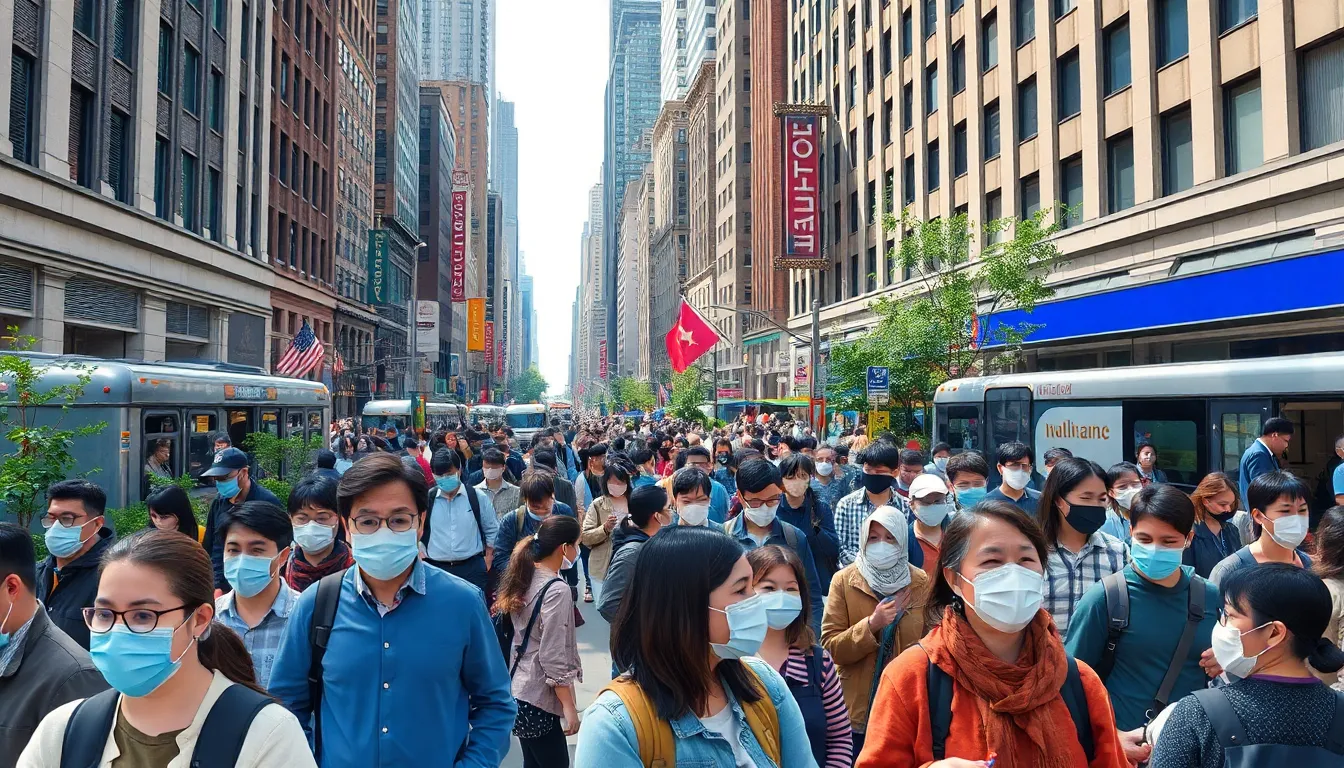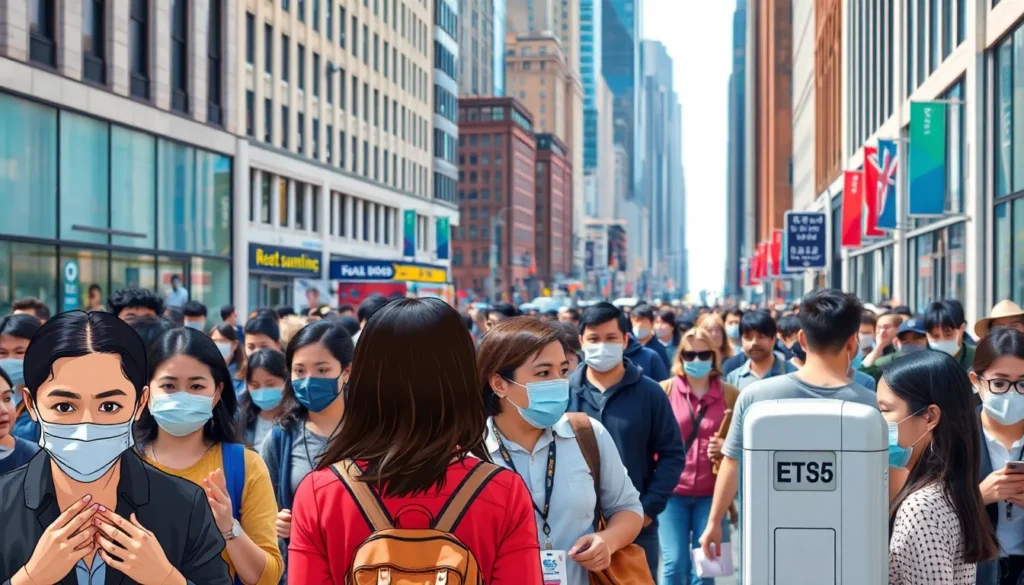In a world where hand sanitizer has become a fashion accessory and toilet paper is the new gold, future pandemic predictions are more relevant than ever. Experts are sounding the alarm bells and diving into data like it’s a pool of disinfectant. What could the next viral villain look like? Spoiler alert: it’s not just a bad case of the sniffles.
Table of Contents
ToggleUnderstanding Future Pandemic Predictions
Experts consistently assess data to predict future pandemics, emphasizing the potential for significant health threats. Research consistently shows that viruses, especially zoonotic ones, frequently emerge from animal to human transmission. Various studies link climate change and urbanization to the increased likelihood of infectious diseases spreading.
The Centers for Disease Control and Prevention (CDC) highlights that surveillance systems must improve for early detection. Data reveals that innovative technologies, like artificial intelligence, improve predictive accuracy regarding outbreak patterns. Predictive models offer insights into how viruses might evolve and spread, allowing for better preparedness.
International cooperation plays a crucial role in pandemic response. Global collaboration enables sharing of real-time data, enhancing public health responses. Countries that invest in robust health systems generally bend the curve of transmission more effectively.
Public awareness contributes significantly to controlling outbreaks. Education on hygiene practices, vaccination, and health behaviors impacts community resilience against infectious diseases. Data from recent health behaviors indicates higher vaccination rates lead to stronger immunity within populations.
Variability in viral mutations further complicates predictions. Understanding this variability helps experts prepare for different scenarios. Predicting the next pandemic requires a multifaceted approach, combining epidemiological data, environmental factors, and human behavior.
Each prediction scenario must consider past pandemics, revealing patterns in viral emergence and spread. Lessons from COVID-19 underline the necessity for rapid response and adaptable health policies. Future readiness hinges on integrating insights from historical data to mitigate risks associated with new pathogens.
Factors Influencing Pandemic Predictions

Understanding factors influencing pandemic predictions is crucial for developing effective response strategies. Multiple elements play significant roles in shaping the likelihood and impact of future outbreaks.
Climate Change
Climate change significantly affects the emergence of infectious diseases. Altered weather patterns can increase the habitats of disease-carrying vectors, such as mosquitoes. Warmer temperatures facilitate the expansion of these species into new regions, enabling pathogens to spread more easily. Moreover, extreme weather events can disrupt existing ecosystems, leading to closer interactions between wildlife and human populations. Increased frequency of zoonotic events correlates with high biodiversity loss, which further elevates risks. According to experts, ongoing changes in climate warrant close monitoring to prevent future health crises.
Globalization
Globalization enhances disease transmission due to increased travel and trade. Easily accessible transportation allows infected individuals to move across borders, spreading pathogens rapidly. The interconnectedness of economies means that an outbreak in one country can quickly impact others. Supply chains also contribute to this phenomenon, making it easier for contaminated goods to circulate widely. Continuous global commerce raises the stakes, as diseases can leap from one region to another in a matter of days. As trade and travel evolve, so do the threats posed by emerging pathogens, necessitating international cooperation for effective monitoring and control.
Population Density
High population density exacerbates the spread of infectious diseases. Crowded urban environments facilitate close contact between individuals, promoting rapid transmission of viruses. The likelihood of outbreak increases in densely populated areas, especially if public health measures weaken. Poor sanitation and limited access to healthcare services further contribute to the potential for widespread infections. Additionally, societal behaviors, such as gatherings and events, elevate exposure risks. Public health officials emphasize addressing these vulnerabilities through urban planning and stronger health infrastructures. Increased awareness and preparedness in highly populated regions can mitigate future pandemic risks.
Emerging Infectious Diseases
Emerging infectious diseases present a significant challenge due to their unpredictable nature. Attention to past outbreaks highlights the need for vigilance in monitoring novel pathogens.
Historical Context
Historical records reveal patterns in the emergence of infectious diseases. The 1918 influenza pandemic exemplified rapid global spread and high mortality rates. SARS in 2003 and MERS in 2012 highlighted the potential for zoonotic diseases to leap from animals to humans. Such occurrences underscored the importance of early detection and intervention. Understanding these past pandemics enhances awareness of the risks associated with new zoonotic pathogens. These lessons emphasize investment in public health infrastructure to prepare for future threats.
Current Trends
Current trends point to increasing incidence of infectious diseases influenced by environmental and social changes. A rise in zoonotic diseases correlates with climate change effects and urban expansion. The World Health Organization estimates that 60% of all known infectious diseases originate from animals. Global travel patterns facilitate rapid transmission, making diseases easier to spread across borders. Furthermore, urban regions with high population densities face heightened risks for outbreaks. Surveillance efforts and vaccination initiatives are crucial to mitigate these risks and protect public health. Insights from prevailing trends inform ongoing strategies to address future pandemics effectively.
Technological Advances in Prediction
Technological advances play a crucial role in predicting future pandemics. Enhanced data analytics and artificial intelligence significantly improve the accuracy and efficiency of outbreak forecasting.
Data Analytics
Data analytics empowers health agencies to detect patterns in infectious diseases. By analyzing vast datasets, experts identify trends and correlations that indicate potential outbreaks. For instance, integrating environmental data with disease reports helps reveal how climate changes affect viral transmission. Furthermore, real-time analytics enable timely updates on infection rates, informing public health responses. Predictive models increasingly utilize historical data to anticipate the emergence of pathogens. Health organizations can implement proactive measures by recognizing these patterns early, ultimately saving lives.
Artificial Intelligence
Artificial intelligence enhances predictive modeling capabilities in epidemic forecasting. Machine learning algorithms analyze diverse data sources, including social media trends and travel patterns, to predict outbreaks. These algorithms adapt and improve as new data becomes available, increasing their predictive power. AI can identify regions at high risk for zoonotic diseases, allowing targeted interventions in vulnerable areas. Moreover, AI-driven simulations can model various scenarios, guiding policymakers on effective responses. Organizations harness these tools to strengthen global health security against potential pandemics.
Public Health Strategies
Public health strategies play a vital role in mitigating future pandemic risks. They encompass various approaches, including vaccination developments and global cooperation.
Vaccination Developments
Vaccination advancements significantly enhance community immunity against emerging infectious diseases. Recent progress includes mRNA vaccine technology, which has proven effective in combating COVID-19, paving the way for rapid vaccine development for future threats. Enhanced global collaborations are underway to streamline vaccine distribution, ensuring equitable access. The importance of maintaining a robust vaccine pipeline cannot be understated since it prepares populations for potential outbreaks. Surveillance programs that monitor vaccine effectiveness also contribute to timely updates and adjustments in vaccination strategies. Overall, these developments aim to fortify public health and prevent the spread of infectious diseases.
Global Cooperation
Global cooperation remains critical to managing and preventing future pandemics. Countries that join forces can share valuable data, enabling earlier detection of potential outbreaks. A coordinated response strengthens health systems, allowing nations to manage resources more efficiently during crisis situations. The World Health Organization plays a key role in facilitating international collaboration, encouraging nations to adopt best practices and vaccination protocols. Participating in joint research initiatives fosters innovation and equips countries with necessary tools to combat emerging diseases. Collective efforts through partnerships and information sharing ultimately enhance global health security and resilience.
Future pandemic predictions highlight the urgent need for vigilance and preparedness in a rapidly changing world. As zoonotic diseases continue to emerge and environmental factors intensify, the importance of robust health systems and international collaboration cannot be overstated. Investing in surveillance technologies and enhancing public health infrastructure will be vital for early detection and rapid response.
The lessons learned from past pandemics serve as a reminder of the unpredictable nature of infectious diseases. By prioritizing education and awareness, communities can build resilience against future threats. Ultimately, a proactive approach that combines technological advancements with global cooperation will be essential in safeguarding public health and mitigating the risks associated with emerging infectious diseases.

